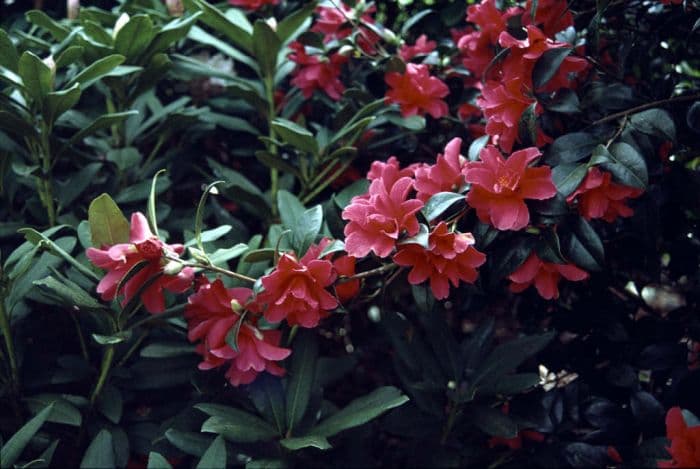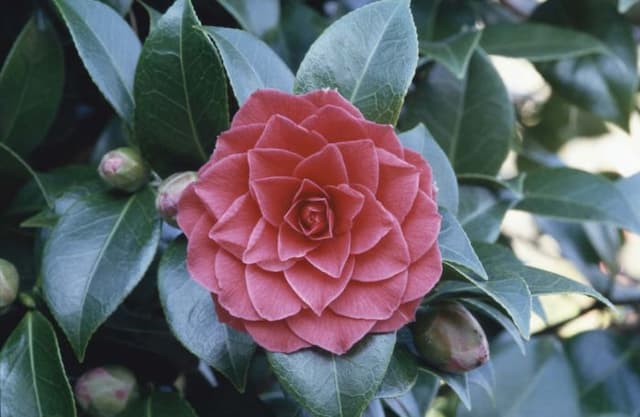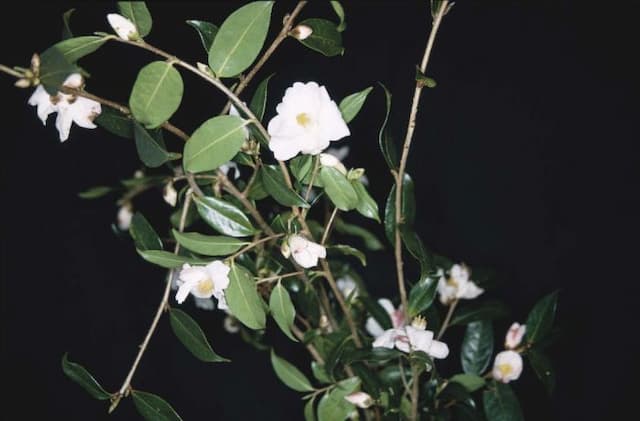Camellia Camellia 'Freedom Bell'

ABOUT
Camellia 'Freedom Bell' is a showy ornamental shrub known for its beautiful, bell-shaped flowers. The blooms are a stunning deep red, drawing the eye with their rich, velvety texture. Each flower is composed of a multitude of petals that are arranged in a way that they curve and cup inward, reminiscent of a bell's shape. This distinctive form gives the plant its name and adds to its ornamental value. The foliage of the Camellia 'Freedom Bell' is also quite attractive. The leaves are glossy and dark green, providing a lush backdrop that further accentuates the vibrant color of the flowers. The leaves are typically oval-shaped with a slightly pointed tip and have a leathery texture, which highlights the overall elegance of the shrub. As the seasons change, the plant continues to provide visual interest. During its blooming period, which typically occurs in the cooler months, the Camellia 'Freedom Bell' becomes a focal point in any garden setting. Even when not in bloom, the evergreen character of the leaves ensures that the plant remains a handsome feature throughout the year.
About this plant
 Names
NamesFamily
Theaceae
Synonyms
Freedom Bell Camellia
Common names
Camellia 'Freedom Bell'
 Toxicity
ToxicityTo humans
Camellia, including the 'Freedom Bell' variety, is generally not considered toxic to humans. Ingesting parts of the plant typically does not lead to serious poisoning. However, it's always advisable to exercise caution and avoid ingesting parts of ornamental plants as they are not intended for consumption, and some individuals might experience mild stomach upset if large quantities are consumed.
To pets
Camellia, including the 'Freedom Bell' variety, is also generally not considered toxic to pets. It is not known to cause serious illness or toxicity in animals such as cats and dogs if they happen to ingest parts of the plant. As with humans, it is always best to prevent pets from eating ornamental plants to avoid the possibility of gastrointestinal upset or an unexpected reaction.
 Characteristics
CharacteristicsLife cycle
Perennials
Foliage type
Evergreen
Color of leaves
Green
Flower color
Red
Height
5-6 feet (1.5-1.8 meters)
Spread
5-6 feet (1.5-1.8 meters)
Plant type
Shrub
Hardiness zones
7
Native area
Asia
Benefits
 General Benefits
General Benefits- Ornamental Value: The Camellia 'Freedom Bell' is prized for its beautiful rosy-red flowers that add color and aesthetic appeal to gardens.
- Seasonal Interest: Blooms in late winter to early spring, providing a burst of color during a time when few other plants flower.
- Drought Tolerance: Once established, it can tolerate periods of drought, making it suitable for gardens with water restrictions.
- Shade Tolerance: Capable of thriving in partial shade, it is an excellent option for underplanting beneath taller trees or in shadowed areas of the landscape.
- Evergreen Foliage: Maintains its glossy, dark green leaves throughout the year, offering continuous greenery even when not in bloom.
- Minimal Maintenance: Requires relatively low upkeep beyond occasional pruning and feeding, ideal for gardeners seeking low-maintenance plantings.
- Wildlife Attraction: Flowers may attract pollinators such as bees, providing a benefit to the local ecosystem.
- Longevity: Camellias are known for their long lifespan, ensuring garden beauty for many years.
- Versatility: Suitable for planting as a single specimen, in groups, or as a part of mixed shrub borders.
 Medical Properties
Medical PropertiesThis plant is not used for medical purposes.
 Air-purifying Qualities
Air-purifying QualitiesThis plant is not specifically known for air purifying qualities.
 Other Uses
Other Uses- As a natural dye: The petals of the Camellia can be used to create natural dyes for fabrics, offering a range of colors from soft pinks to deeper shades depending on the mordant used.
- As a garnish: The flowers of the Camellia plant can be utilized as edible garnishes for cakes and desserts, adding elegance and a touch of natural beauty to the presentation of dishes.
- In floral crafts: Camellia flowers can be pressed and used in crafting, such as in handmade paper, bookmarks, or in resin jewelry, preserving their beauty.
- In photography: The vibrant flowers of the Camellia can serve as a compelling subject for botanical photography, allowing photographers to capture their intricate details.
- As a natural ink: The petals can be crushed to create a delicate, natural ink for art projects, such as calligraphy or watercolor painting.
- In ceremonies: In some cultures, Camellia flowers may be used in wedding ceremonies or other events as a symbol of love or affection.
- In potpourri: Dried Camellia petals can be mixed into potpourri blends for a natural, fragrant addition to a home's décor.
- As a natural confetti: Instead of using paper or plastic confetti, biodegradable Camellia petals can be tossed at celebrations for an eco-friendly alternative.
- In ice sculptures: Frozen into ice sculptures or ice cubes, Camellia flowers can add a touch of floral elegance to weddings or fancy cocktails.
- As bookmarks: Dried Camellia flowers can be laminated or sewn into fabric bookmarks as a charming gift for book lovers.
Interesting Facts
 Feng Shui
Feng ShuiThe Camellia is not used in Feng Shui practice.
 Zodiac Sign Compitability
Zodiac Sign CompitabilityThe Camellia is not used in astrology practice.
 Plant Symbolism
Plant Symbolism- Admiration: The beauty of the camellia often garners admiration from onlookers.
- Perfection: Its flawless form is frequently seen as a symbol of ideal beauty and excellence.
- Love: In many cultures, giving a camellia represents expressing love for someone.
- Affection: It can also signify deep affection towards someone, whether familial or romantic.
- Longevity: As an evergreen plant, camellias symbolize long life and enduring spirit.
- Gratitude: Presenting camellias is a way to say 'thank you' and show appreciation.
 Water
WaterCamellias, including the 'Freedom Bell' Camellia, prefer consistently moist soil but do not do well with waterlogged roots. They should be watered deeply and thoroughly to ensure that the moisture reaches the root zone. During the growing season, water to provide at least an inch of moisture per week, which for a medium-sized plant equates to roughly 0.5 gallons. In the absence of rain, this may require supplemental watering, especially during prolonged dry spells. It's crucial to reduce watering in the winter months when the plant is not actively growing. The frequency of watering will depend on soil type and climate, but generally, watering every 5 to 7 days during active growth is sufficient. Use the finger test to check the soil moisture level; water when the top couple of inches of soil feel dry to the touch.
 Light
LightCamellia 'Freedom Bell' grows best in partial shade to dappled sunlight. It thrives under the protection of high tree canopies that provide filtered light. Avoid placing it in direct afternoon sun, especially in hotter climates, as this may cause the leaves to scorch. Morning sunlight with afternoon shade works well for Camellias and will help bloom production without causing heat stress. Ensure the plant is located in a spot with indirect light for the greater part of the day for optimal growth and flowering.
 Temperature
TemperatureThe 'Freedom Bell' Camellia is hardy in USDA zones 7-9, and it prefers temperatures that are consistently cool to moderate. The minimum temperature for Camellias to survive is typically around 0 to 10 degrees Fahrenheit, but their ideal temperature range for flourishing is between 40 and 70 degrees Fahrenheit. They can tolerate short periods of colder weather down to about 5 degrees Fahrenheit, but prolonged exposure to temperatures below this can cause damage to the plant.
 Pruning
PruningPrune the 'Freedom Bell' Camellia to maintain shape, remove any dead or crossing branches, and to promote healthy growth. The best time to prune is just after the blooms have faded in the spring to avoid cutting off next year's buds. Camellias set their flower buds in the early summer for the following season, so late pruning can remove these buds and reduce flowering. Annually pruning or at least every other year will help keep the plant looking its best and encourage more prolific blooming.
 Cleaning
CleaningAs needed
 Soil
SoilCamellias require acidic soil with a pH between 5.5 and 6.5 for optimal growth. A good soil mix for Camellia 'Freedom Bell' would consist of equal parts well-draining potting soil, peat moss, and pine bark. This composition ensures both moisture retention and good drainage, key to avoiding root rot while providing an acidic environment.
 Repotting
RepottingCamellia 'Freedom Bell' should be repotted every two to three years or when it becomes root-bound. It's best to repot in the late winter or early spring just before new growth begins, using an acidic soil mix and a slightly larger pot to accommodate root growth.
 Humidity & Misting
Humidity & MistingThe Camellia 'Freedom Bell' prefers high humidity levels, around 50-60%. To maintain optimal humidity, one can use a humidifier, place a water tray beneath the plant, or mist the leaves regularly, avoiding over-wetting to prevent fungal diseases.
 Suitable locations
Suitable locationsIndoor
Provide bright, indirect light and maintain acidic soil.
Outdoor
Place in partial shade, sheltered from harsh sun and wind.
Hardiness zone
7-9 USDA
 Life cycle
Life cycleCamellia 'Freedom Bell' begins its life as a seed, which, under suitable conditions, germinates to produce a small seedling. The seedling then enters a vegetative growth stage, developing a root system and foliage as it matures into a young plant. Over several years, Camellia 'Freedom Bell' grows into a mature shrub with dense, glossy, evergreen leaves. Upon reaching maturity, the plant begins its reproductive phase, typically producing red, bell-shaped flowers in the fall or winter, depending on the climate. After pollination, flowers give way to seed capsules which ripen and eventually release seeds to start the cycle anew. Throughout its life cycle, Camellia 'Freedom Bell' may undergo periods of dormancy, especially in colder climates, to survive adverse weather conditions until favorable growth conditions return.
 Propogation
PropogationPropogation time
Spring-Early Summer
The Camellia 'Freedom Bell', commonly referred to simply as Camellia, is typically propagated through semi-hardwood cuttings. This method involves taking a cutting from new growth that has started to mature and harden off, generally in late summer or early fall. Cut a 4 to 6 inch (10 to 15 centimeters) portion from the stem, ensuring it includes at least two leaf nodes. The lower leaves are then removed, and the cut end is dipped in rooting hormone to encourage root development. The prepared cutting is then placed in a well-draining potting mix, thoroughly watered, and kept in a warm, humid environment, often under some form of protective covering like a plastic bag or a propagator to maintain consistent humidity. Roots typically form within a few months, after which the cutting can be gradually acclimated to less humid conditions and eventually transplanted outdoors.









